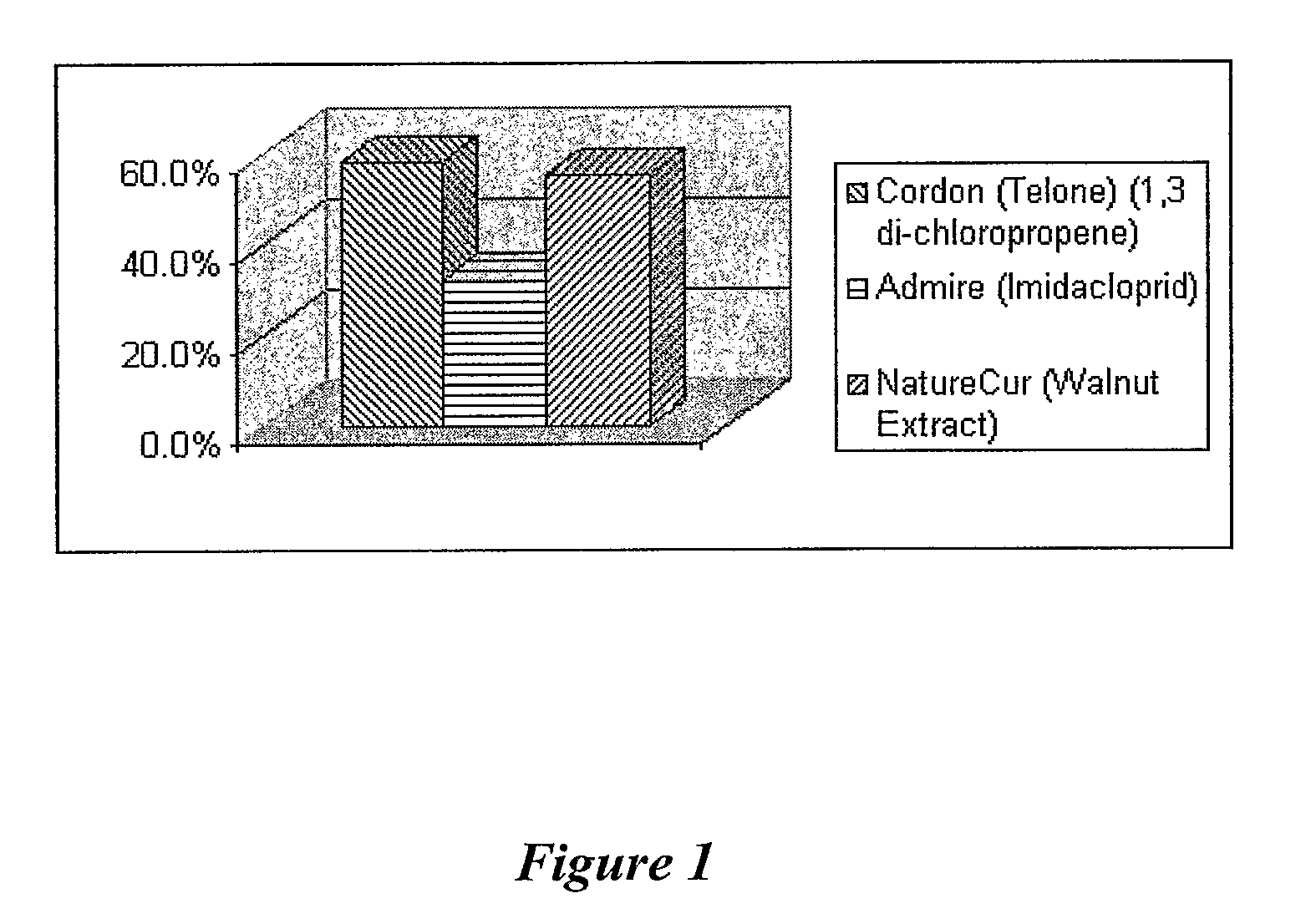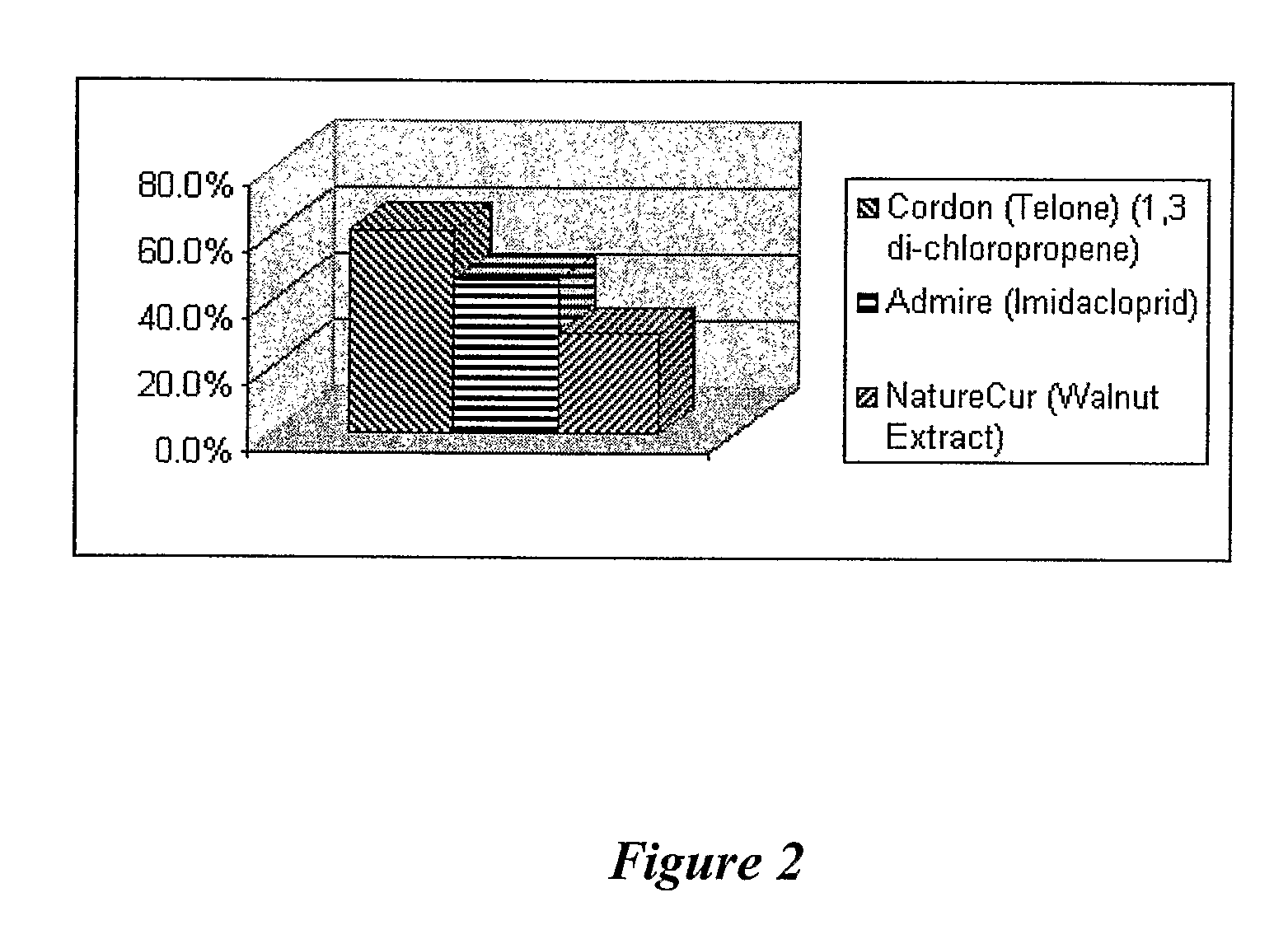Nematicides from Juglandaceae and methods of use thereof
a technology of juglandaceae and nematodes, which is applied in the directions of biocide, application, plant/algae/fungi/lichens ingredients, etc., can solve the problems of millions of dollars of damage to turf grass, toxic to wildlife, plant parasites, etc., and achieve the effect of inhibiting the damage of said first plan
- Summary
- Abstract
- Description
- Claims
- Application Information
AI Technical Summary
Benefits of technology
Problems solved by technology
Method used
Image
Examples
example 1
[0079]This Example describes an exemplar composition of the invention.
[0080]To make an exemplar 100 pounds of a 1% solution of a juglone-producing plant of the family Juglandaceae, the following is mixed:
Mix 1:
[0081]41 pounds deionized water, and[0082]pounds tetrapotassium pyrophosphate,[0083]for a total of 51 pounds of Mix 1.
Mix 2:[0084]14 pounds of 70% ethanol,[0085]10 pounds of 99% acetic acid, and[0086]1 pound of walnut hulls,[0087]for a total of 25 pounds.
Mix 3:[0088]22 pounds of deionized water, and[0089]2 pounds of citric acid,[0090]for a total of 24 pounds.
[0091]The three mixes were mixed together, for a total of 100 pounds of product.
[0092]The walnut hulls can be left in the solution or, preferably, filtered or strained out of the liquid before application to plants or the field.
[0093]In the Example above, the three mixes were prepared separately for convenience of dissolving the different solutes. Since Mix 2 should steep for 24-48 hours, it can be made before the other tw...
example 2
[0095]A field trial was conducted on an orange grove, comparing the effect of the composition described in Example 1 (under its trade name, NatureCur™) against two widely used, commercially available nematicides, an emusifiable concentrate of 1,3 dichloropropene which can be applied to the soil after plants are planted (called a “post-plant” application) (Dow AgroSciences LLC, Indianapolis, Ind.), shown on the accompanying charts as “Cordon,” and imidacloprid, an insecticide marketed under the name Admire® (Bayer CropScience LP, Research Triangle Park, N.C.). For the soil treated with Cordon and the soil treated with Admire®, single applications of the agents were made in mid-May. The product NatureCur™ was applied in once in mid-May, once 30 days later in mid-June, and once again 30 days later in mid July, each time at a concentration of 5000 ppm. The soil in the grove was a clay loam, a very dense, heavy soil in which it is difficult to get agents to travel. Thus, the soil in this...
example 3
[0101]A field trial was conducted on a carrot farm to compare the effect on nematode levels of the composition described in Example 1 (under its trade name, NatureCur™) against two widely used, commercially available nematicides, Telone® II, a soil fumigant form of 1,3 dichloropropene (Dow AgroSciences LLC, Indianapolis, Ind.), and Vapam® (anhydrous sodium N-methyldithiocarbamate, Amvac Chemical Corp., Los Angeles Calif.). According to the manufacturer, when Vapam® contacts soil, it converts into methyl isothiocyanate, a volatile, highly toxic fumigant.
[0102]In carrots, nematodes which attack the tip of the plant during the first 20 days post emergence cause the carrot to “fork”. Forked carrots are unmarketable, and nematodes are the primary cause of forking. Thus, determining the percentage of carrots that are forked serves as a measure of how much the compositions tested can reduce the economic loss or damage caused by nematodes to a carrot population.
[0103]The test area was divid...
PUM
| Property | Measurement | Unit |
|---|---|---|
| time | aaaaa | aaaaa |
| pH | aaaaa | aaaaa |
| temperature | aaaaa | aaaaa |
Abstract
Description
Claims
Application Information
 Login to View More
Login to View More - R&D
- Intellectual Property
- Life Sciences
- Materials
- Tech Scout
- Unparalleled Data Quality
- Higher Quality Content
- 60% Fewer Hallucinations
Browse by: Latest US Patents, China's latest patents, Technical Efficacy Thesaurus, Application Domain, Technology Topic, Popular Technical Reports.
© 2025 PatSnap. All rights reserved.Legal|Privacy policy|Modern Slavery Act Transparency Statement|Sitemap|About US| Contact US: help@patsnap.com


